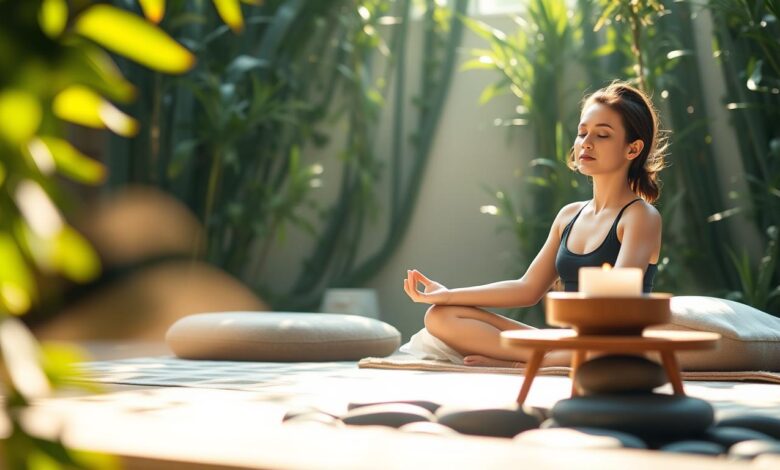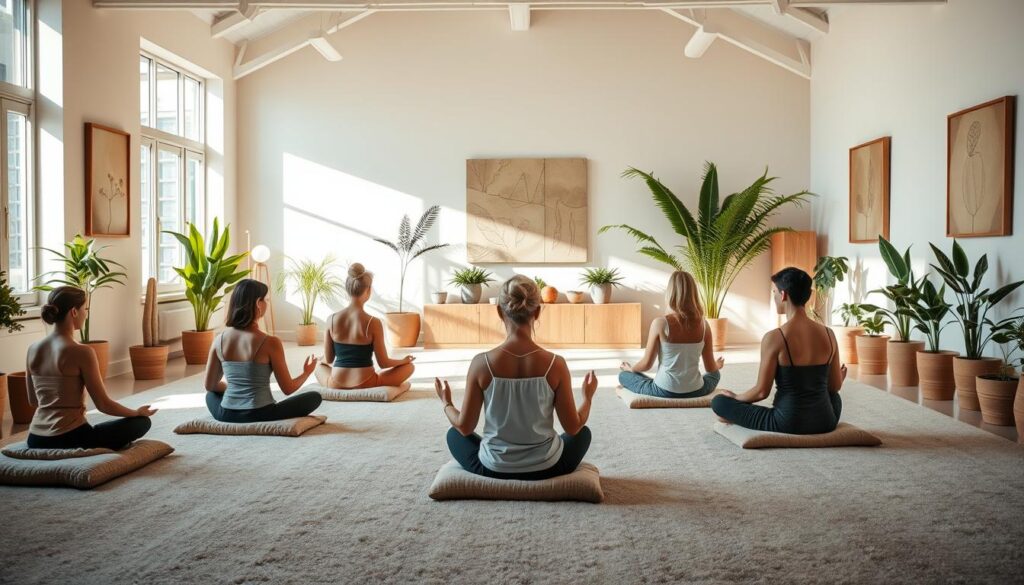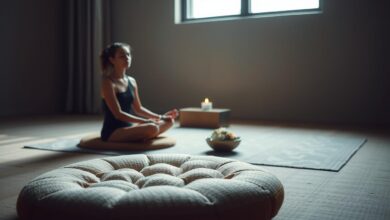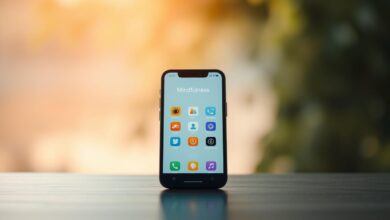Mindfulness Exercises for Beginners: Calm Your Mind

Ever feel like your thoughts are racing? Stuck between deadlines, notifications, and tomorrow’s tasks? You’re not alone. Life’s noise can make even the calmest feel scattered. But, there’s a way to pause, breathe, and find clarity.
Mindfulness meditation for beginners is that way. It’s a tool to step back from stress, reconnect with the present, and build resilience. It’s not about emptying your mind—it’s about noticing your experiences without judgment. This article will show you simple practices to find calm in everyday moments. You’ll learn to create your own mindfulness meditation script, tailored to your goals.
Key Takeaways
- Start small: Even 5 minutes of daily practice can improve mindfulness meditation benefits like reduced anxiety.
- Anyone can learn—no special skills or beliefs required.
- Mindfulness meditation for beginners focuses on awareness of breath, body, and surroundings.
- Simple techniques like mindful breathing or body scans build a foundation for deeper practice.
- Tracking progress through journals helps measure mindfulness meditation benefits over time.
What is Mindfulness Meditation?
Mindfulness meditation is about being fully present in the moment without judgment. It trains your mind to notice thoughts and feelings as they happen. This helps you respond wisely, not just react.
Definition of Mindfulness
Mindfulness is about paying attention on purpose. When you meditate, you focus on the present. Techniques like watching your breath or scanning your body help you stay present. This simple method is the heart of mindfulness meditation.
Benefits of Practicing Mindfulness
Research shows many benefits of mindfulness meditation:
- Less anxiety and stress
- Better focus and mental clarity
- Stronger emotional resilience
- Improved sleep
The Science Behind Mindfulness Meditation
Studies show regular practice strengthens brain connections for focus and empathy. Brain scans reveal more gray matter in emotion control areas. Harvard found it lowers stress hormone levels.
By adding mindfulness to your daily routine, you’re not just calming your mind. You’re changing how your brain handles challenges. Ready to see how it works?
Getting Started with Mindfulness
Starting mindfulness meditation doesn’t need to be perfect. It’s about being intentional. Follow these steps to create a habit that fits your life.
Creating a Meditation Space
Even a small corner can be your sanctuary. Here’s how to set it up:
- Choose a quiet area with minimal distractions.
- Add a cushion, chair, or blanket for comfort.
- Include calming elements like plants, soft lighting, or a scented candle.
Don’t worry about perfection. A kitchen table or cozy nook works great too.
Setting a Consistent Schedule
Consistency is key, not how long you meditate. Try this:
- Pick a daily time, even if it’s just 5 minutes.
- Link it to an existing habit, like after brushing your teeth.
- Use reminders on your phone to stay on track.
Stick to it for two weeks to build the habit. Then, adjust as needed. Flexibility is important.
Choosing the Right Time for You
Find the best time for your energy levels:
| Time of Day | Best For | Tips |
|---|---|---|
| Mornings | Starting the day with clarity | Use a gentle alarm and stretch first. |
| Evenings | Unwinding after work | Dim lights and a cool room help focus. |
| Midday | Quick reset during busy schedules | Use a 3-minute breath-focused practice. |
Track how different times affect your focus. This will help refine your routine.
Basic Mindfulness Techniques
Starting a mindful practice is easy. You don’t need experience. Here are three simple ways to focus and relax.
“The body scan helps you reconnect with your physical sensations, fostering a deeper sense of presence.” – Jon Kabat-Zinn
Breathing Exercises for Beginners
Begin with these breathing exercises to find calm:
- Counted Breathing: Inhale for 4 counts, hold 2, exhale for 6. Repeat 5 times.
- Breath Awareness: Feel the cool air and warm air as you breathe.
- Diaphragmatic Breathing: Place hands on chest and belly. See your belly rise more.
Body Scan Meditation
Start by lying down or sitting. Follow these steps:
- Clench fists, then release. Notice the difference in tension.
- Focus on your body from toes to head. Pause at each spot.
- End by feeling your whole body. This takes 10–15 minutes, but 3 minutes is good too.
Walking Meditation Basics
Make walking a mindful activity:
- Walk slowly, feeling each foot touch the ground.
- Match steps with breath: “Left foot down (inhale), right foot down (inhale), left foot lifts (exhale). Repeat.)
- If your mind wanders, bring it back to your steps.
These exercises fit into your day. Use them during breaks, before bed, or when stressed. Pick one to try today.
Developing a Mindfulness Meditation Script
Creating your own mindfulness meditation script lets you design a practice that aligns with your goals. Start by outlining a structure that guides your focus step by step. Here’s how to build a personalized script:
Structure of a Meditation Script
Every effective script follows three core parts:
- Opening: Begin with a few deep breaths to signal your mind to relax.
- Main Practice: Choose a focus like breath, sounds, or body sensations.
- Closing: Gradually return to the present moment, carrying calm into your day.
Incorporating Personal Goals
Ask yourself: What do you want to achieve? For stress relief, include prompts like, “Notice tension melting with each exhale.” Use phrases like:
- “Visualize challenges as clouds passing by.”
- “Focus on gratitude for small moments of joy.”
Using Imagery and Visualization
Imagery brings your script to life. Picture a peaceful scene, like walking through a forest or sitting by a lake. A quote from mindfulness expert Jon Kabat-Zinn reminds us:
“Imagination is a powerful tool to anchor awareness in the present.”
Practice adapting these elements to craft scripts that resonate with you. Share your experiences or explore guided mindfulness meditation apps like Headspace for inspiration. Your script evolves as you do—making mindfulness a tool that grows with your needs.
Guided Meditation Options
Guided mindfulness meditation is a great way to start your mindfulness journey. It offers structure and guidance, helping you stay focused. You can find these sessions on apps and websites, catering to all levels of experience.
Benefits of Guided Meditation
Guided sessions give you clear instructions, reducing uncertainty. You’ll follow a steady pace and explore new techniques. You can even focus on stress relief or improving sleep. Studies show it boosts consistency and engagement more than unguided methods.
“A teacher’s voice anchors the mind, helping you stay present during practice.” – Mindfulness instructor Sarah Dalton
Popular Apps and Resources
- Headspace: 14-day free trial with themed guided sessions
- Calm: Nature sounds and sleep stories for daily practice
- Insight Timer: Over 50,000 free guided meditations
Free Online Guided Meditations
YouTube channels like Mindful and Spotify playlists from 10% Happier are great options. Universities like UCLA also offer free audio guides on their websites. These platforms let you try mindfulness meditation online without any cost.
Overcoming Challenges in Mindfulness Meditation
Starting mindfulness meditation can be tough, but it’s part of the journey. Many face similar hurdles. Knowing how to deal with them can help you grow.

Common Obstacles for Beginners
Even with good intentions, challenges pop up. Common ones include:
- Mind-wandering during sessions
- Physical discomfort from sitting for long
- Feeling impatient with slow progress
- Critical self-talk like “I’m not doing this right”
Strategies to Stay Focused
Here are some tips to keep your practice strong:
- Anchor techniques: Use your breath or a mantra as a focus point when distracted.
- Gentle redirection: Notice stray thoughts, then gently return to your focus without judgment.
- Progressive skill building: Start with short sessions, then increase time as you get more comfortable.
Dealing with Distractions
Distractions can be internal (thoughts) or external (sounds). Here’s how to tackle both:
External distractions: Use noise-canceling headphones or find quiet times. Soft music or a fan can help block out background noise.
Internal distractions: Think of thoughts as clouds passing by. Let them go while focusing on your breath.
“The goal isn’t to empty the mind, but to observe without attachment,” says mindfulness pioneer Jon Kabat-Zinn. Embrace imperfection to build resilience.
Consistency is key, not perfection. Regular practice strengthens your mental muscles, helping you overcome challenges over time.
Mindfulness in Daily Life
Bringing mindfulness into everyday moments can make life calmer and more focused. Here’s how to add these practices to your daily routine easily.
Mindful Eating Practices
Make meals into mindfulness exercises by eating slowly. Pay attention to the food’s texture, temperature, and taste. Ask yourself: Am I truly hungry, or just bored? Take breaks between bites to enjoy each mouthful fully.
Mindfulness During Routine Activities
Make chores into mindfulness exercises. Here’s how to do it while washing dishes:
- Feel the warmth of the water.
- Listen to the sound of suds.
- Focus on the rhythm of scrubbing.
Even commuting can become a mindful experience. Notice the bus’s hum, the feel of your seat, or the coffee smell from others.
Fostering Awareness in Daily Interactions
“The present moment is filled with joy and wonder if only you let yourself be aware of it.” — Eckhart Tolle
Practice active listening: turn off phones and really listen. When someone talks, nod, repeat what they said, and respond thoughtfully. This strengthens your awareness and builds deeper connections.
Tracking Your Progress
Starting your journey is easy. A mindfulness journal lets you track small victories and hurdles. Note any changes in focus, calmness, or clarity after each mindfulness meditation session. This helps you see how your practice changes your daily life.

Keeping a Mindfulness Journal
- Write brief notes after each session, like, “Today’s breathwork felt grounding.”
- Track how often you practice and how long you meditate.
- Note moments when mindfulness techniques helped you in daily stress.
Reflecting on Experience and Growth
Ask yourself: “What felt easier this week compared to last?”
Weekly reviews help spot patterns. Celebrate even tiny shifts, like noticing tension before reacting to stress. Growth isn’t linear—acknowledge progress without pressure.
Assessing Your Mindfulness Practice
Set aside five minutes weekly to assess your mindfulness meditation practices. Rate focus on a scale of 1–5. Identify what routines feel most beneficial. Adjust your approach gently if certain methods no longer resonate.
Progress isn’t about perfection. It’s about noticing how mindfulness becomes a natural part of your rhythm. Every entry in your journal is a step toward understanding your unique path.
Resources for Further Learning
As you continue your mindfulness journey, these resources can help deepen your practice. They connect you with like-minded individuals. Explore curated options tailored to your goals, whether you seek stress relief, emotional balance, or spiritual growth.
Guided Learning Through Books and Audio
Books like “The Miracle of Mindfulness” by Thich Nhat Hanh and “Mindfulness: An Eight-Week Plan for Finding Peace in a Frantic World” offer foundational wisdom. Many include mindfulness meditation audio recordings to enhance daily practice. Audiobooks and podcasts from platforms like Audible or Insight Timer provide portable guidance for on-the-go sessions.
Online Courses and Digital Tools
Online platforms like Coursera and Udemy host structured mindfulness meditation online courses taught by experts. Apps such as Calm and Headspace offer guided sessions, tracking features, and specialized programs. Free resources like UCLA’s Mindful Awareness Research Center provide downloadable mindfulness meditation audio guides to practice anytime.
Connecting Locally and Globally
Join local meditation groups via Meetup or community centers to share experiences and attend workshops. National organizations like the Institute of Meditation and Psychotherapy host events that blend mindfulness with modern life. Online forums and social media groups also foster global connections, providing support and inspiration.




